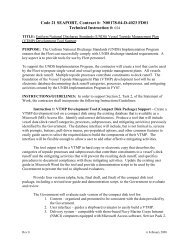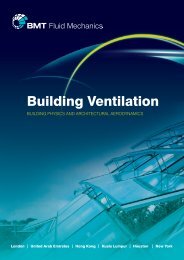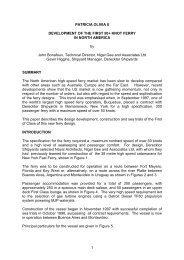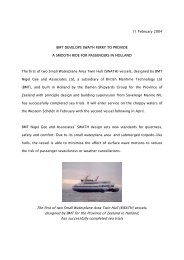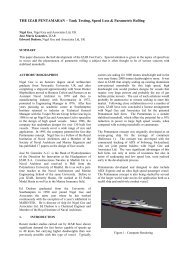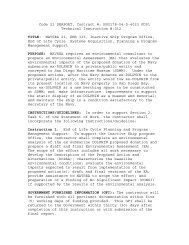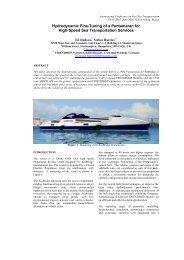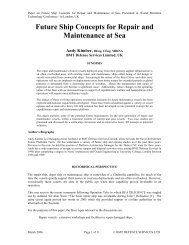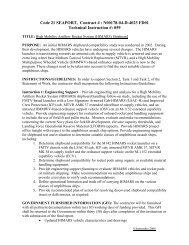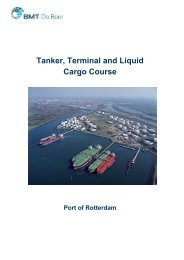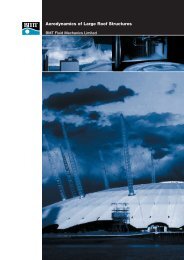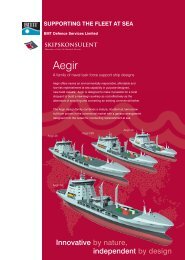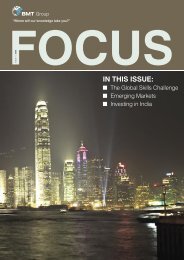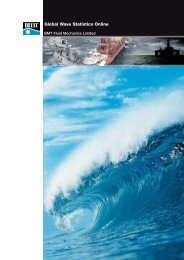Stadia & large span roof structures - BMT Group
Stadia & large span roof structures - BMT Group
Stadia & large span roof structures - BMT Group
You also want an ePaper? Increase the reach of your titles
YUMPU automatically turns print PDFs into web optimized ePapers that Google loves.
<strong>Stadia</strong> & <strong>large</strong> <strong>span</strong><br />
<strong>roof</strong> <strong>structures</strong><br />
wind engineering & architectural aerodynamics<br />
London London | Hong | Hong Kong Kong | Kuala | Kuala Lumpur Lumpur | Abu | Dhabi Abu Dhabi | Dubai | Dubai | Shanghai | Shanghai | Houston
sports stadia and <strong>large</strong> <strong>span</strong> <strong>roof</strong> <strong>structures</strong> of increasingly unprecedented<br />
scale are being designed, incorporating landmark architecture and<br />
innovative structural design.<br />
cost effective design of <strong>large</strong> <strong>span</strong> <strong>roof</strong> <strong>structures</strong> of<br />
complex external envelope is dictating light-weight design,<br />
making these <strong>roof</strong> <strong>structures</strong> highly sensitive to loading<br />
such as wind and snow. in order for sophisticated 3d<br />
structural modelling to deliver efficient structural design,<br />
accurate loading scenarios are required for wind that<br />
account for complex fluid-structure interactions including<br />
wind driven dynamic effects. wind related environmental<br />
effects such as pitch microclimate and spectator comfort<br />
Key services<br />
• wind climate analysis<br />
• <strong>roof</strong> structural load & dynamic response analysis<br />
• Pedestrian wind comfort analysis /environmental impact<br />
assessment<br />
• Façade pressure analysis<br />
• snow & sand accumulation / drift analysis<br />
• spectator comfort analysis<br />
• Pitch microclimate analysis<br />
• Ball flight analysis<br />
Zurich Stadium<br />
and external microclimate all require careful consideration<br />
from an early stage in design. Bmt Fluid mechanics<br />
(Bmt) operates a highly specialised and resourceful<br />
stadia and <strong>large</strong> <strong>roof</strong> <strong>structures</strong> group that provides<br />
designers with a comprehensive portfolio of consultancy<br />
services for structural, serviceability and environmental<br />
design based on substantial in house capabilities and<br />
experience for boundary layer wind tunnel testing and<br />
numerical modelling.<br />
Key BeneFits<br />
• cost-effective structural design<br />
• cost-effective façade design<br />
• optimised occupant / spectator comfort<br />
• external microclimate control<br />
• interactive solution development<br />
• iterative design optimisation<br />
Beijing Olympic Stadium<br />
Wind Frequency Data<br />
Wind Climate<br />
the specification of design wind speeds for structural,<br />
serviceability and environmental design requires careful<br />
analysis of long-term wind statistics. Bmt has access to<br />
global wind record databases, which provide long-term<br />
wind statistics for extreme wind events including synoptic<br />
and non-synoptic wind patterns including e.g. typhoon,<br />
shamal, and thunderstorm.<br />
By application of sophisticated industry-standard wind<br />
models of the atmospheric boundary layer and extreme<br />
value statistical analysis of storm records, site-specific<br />
Wind Speed vs. Return Period<br />
Non-synoptic Wind Profile<br />
wind climate models are generated for each development<br />
that can also provide detailed resolution of wind<br />
directionality and probability of occurrence.<br />
where required, generic wind models are complemented<br />
through detailed modelling of non-synoptic wind patterns<br />
using approaches such as topography modelling and<br />
mesoscale models. wind climate studies are accepted<br />
throughout the world by local building departments and<br />
regulatory bodies and deliver a robust basis for reduction<br />
of inherent conservatism in design codes.<br />
Mesoscale Model<br />
Tel: +44 20 8614 4400 Fax: +44 20 8943 3224 Email: enquiries@bmtfm.com Website: www.bmtfm.com
Structural Load Effects Pressure Distribution Load Effect vs. Wind Angle<br />
StruCtural loadS / dynamiC reSponSe analySiS<br />
dynamic wind loading is many cases a governing<br />
parameter in the design of the primary and secondary<br />
structural support systems of the <strong>roof</strong> of <strong>large</strong> sports<br />
stadia and <strong>large</strong> <strong>span</strong> <strong>roof</strong> <strong>structures</strong>. cost efficient<br />
design of these components requires reliable<br />
quantification of these wind parameters.<br />
Boundary layer wind tunnel testing based on high<br />
frequency pressure integration (hFPi) techniques allow<br />
Pressure Model<br />
accurate determination of critical loading scenarios<br />
dictating for the structural stiffness of the <strong>roof</strong>. in<br />
particular, this technique allows detailed analysis of<br />
structural load effects such as net uplift / downforce and<br />
vertical shear cases based on structural influence lines<br />
thereby delivering loading scenarios for structural design<br />
which are substantially less conservative than applicable<br />
codes of practice.<br />
StruCtural loadS / dynamiC<br />
reSponSe analySiS Cont<br />
Bmt operates a state-of-the-art, custom built, 1152<br />
channel simultaneous low-range pressure scanning<br />
system that allows unsteady external pressure fields to be<br />
measured to a high degree of spatial resolution.<br />
wind tunnel data can be reanalysed iteratively for different<br />
structural parameters such as stiffness and damping as<br />
the design evolves eliminating the need for repeat testing<br />
allowing for efficient tuning of the structural system.<br />
Wind driven SnoW & Sand drift / aCCumulation analySiS<br />
depending on local climate wind driven sand or snow<br />
accumulation and drift can cause significant loading<br />
on <strong>large</strong> <strong>span</strong> <strong>roof</strong> <strong>structures</strong>. codified methodology<br />
available to designers is often rather simplistic and when<br />
applied to complex <strong>roof</strong> arrangements and can lead to<br />
overly conservative structural design solutions.<br />
Flow Across the Roof<br />
Bmt have purposely developed a number of sophisticated<br />
physical and numerical modelling techniques including<br />
aeolian transport and particle tracking models to provide<br />
designers with the opportunity to study the effects in<br />
greater detail and to derive more bespoke quantification<br />
of key loading scenarios.<br />
Tel: +44 20 8614 4400 Fax: +44 20 8943 3224 Email: enquiries@bmtfm.com Website: www.bmtfm.com<br />
Sand drift<br />
CFD Sand Drift<br />
Snow Drift
Cladding preSSure analySiS<br />
cladding pressures on glazed facades and <strong>roof</strong><br />
cladding systems can be accurately measured using<br />
detailed small-scale wind tunnel models instrumented<br />
with pressure taps.<br />
internal pressures can be quantified using<br />
computational internal airflow models. sophisticated<br />
3d contouring software allowing automated on-line<br />
presentation of surface pressure data for complex<br />
external building form allows the façade pressures to<br />
be effectively displayed in a way that is easily digested<br />
into cost effective façade/cladding system design by<br />
façade contractors.<br />
pedeStrian and SpeCtator Comfort / pitCh miCroClimate<br />
generating controlled external and internal microclimate<br />
in the vicinity of stadia and <strong>large</strong> <strong>span</strong> <strong>roof</strong> <strong>structures</strong> by<br />
purposeful development of wind mitigation schemes that<br />
protect from the unfavourable action of downdrafts and<br />
ground level wind funnelling is key to the commercial<br />
success of external recreational spaces as well as internal<br />
seating areas and is key to ensuring user comfort.<br />
Bmt operates multiple channel wind speed sensing<br />
systems that allow the wind speed up to be quantified in<br />
severity and spatial extent in key pedestrian areas and<br />
for pedestrian wind comfort to be defined in terms of<br />
suitability for planned uses.<br />
Cladding Pressure Contours<br />
Block Zone Diagram<br />
Comfort & Safety Rating<br />
pedeStrian and SpeCtator Comfort / pitCh miCroClimate Cont<br />
Bmt’s interactive approach to pedestrian wind comfort<br />
studies allows designers to develop wind mitigation<br />
schemes and validate these for effectiveness through<br />
time and cost efficient interactive wind tunnel test<br />
work-shop days.<br />
in addition, numerical models can be applied to<br />
quantify sunlight / overshadowing effects and coupled<br />
dynamic thermal modelling allows thermal comfort to be<br />
determined. Bmt’s technical and interpretative reporting<br />
is compatible with environmental impact assessment<br />
formats required by planning authorities.<br />
Suitability Classification<br />
Tel: +44 20 8614 4400 Fax: +44 20 8943 3224 Email: enquiries@bmtfm.com Website: www.bmtfm.com<br />
Wind Speed Up<br />
Thermal Comfort<br />
Shadow Movement<br />
Pitch Microclimate
For further information contact:<br />
Tel: +44 20 8614 4400 Fax: +44 20 8943 3224<br />
Email: enquiries@bmtfm.com Website: www.bmtfm.com<br />
<strong>BMT</strong> Fluid Mechanics Limited, 67 Stanton Avenue, Teddington, Middlesex, TW11 0JY, UK



